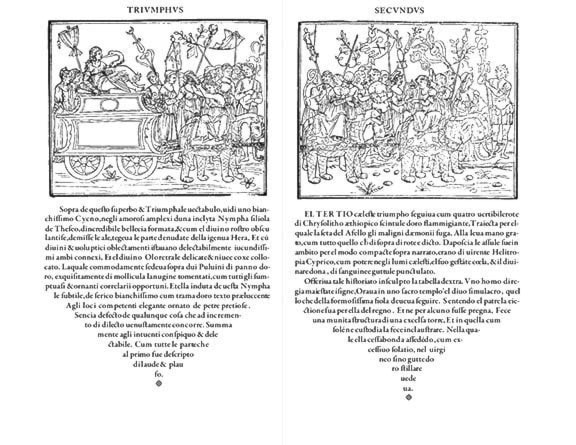Mike Selby
It is arguably the most unusual book ever published. Its plot is unknowable; its text unreadable. No one is certain who wrote it. No one is certain on what the book is about. Its title — the 'Hypnerotomachia Poliphili' — is almost as torturous to say as it is to read. Yet it remains one of the most remarkable if indecipherable books of all time.
The 'Hypnerotomachia Poliphili' was published in Venice in 1499. Subtitled 'The Strife of Love in a Dream,' it tells the story of Poliphilo, his love for Polia, and his journey in trying to win her heart. While this plot may seem simple enough, finding it within the book's pages is nothing short of a miracle.
The first stumbling block is the language it is written in. Not only did the author use an obscure form of Latinate Italian (obscure even in the 15th century), but he also peppered sentences with Greek, Hebrew, Arabic, Egyptian hieroglyphs, and, when no word existed for his purposes, he made up his own. The author would also take words from one language and force them into the syntax from another. If this wasn't hard enough to read, the text on each page is printed in the shape of a medieval goblet and other bizarre objects.
Less difficult to understand is the book's 174 breathtaking woodcuts, each one seen as a "perfect balance of weight and colour." The images are made up of detailed architecture, gardens, landscapes, Roman Gods, and costumes. It is unknown who the artist of the book was, although a young Raphael has been suggested from time to time.
The 'Hypnerotomachia Poliphili' lists no author, but the first letter from each of the book's 34 chapters spells "Brother Francesco Colonna greatly loved Polia." Now there was a priest named Francesco Colonna living in Venice at the time of the book's initial publishing. Since a lot of the book appears to be about sexual obsession, one could see Colonna not signing his name to it. Yet there was also a wealthy Roman Governor also named Francesco Colonna at this time. And some scholars believe it was written by Lorenzo de' Medici.
Nothing about this book is easy, and all efforts to translate successfully into English have failed, until musicologist Joscelyn Godwin did in 1999 — exactly 500 years after the book's publication.
And even after all these centuries there is still no consensus as what exactly the 'Hypnerotomachia Poliphili' really is. While some see the "strange, pagan, pedantic, erotic, allegorical, mythological romance" as work of perplexing yet masterful genius, others find it "unreadable," "impenetrable," and "a serious runner up for the title of most boring work in Italian literature."
Anyone still interested in the book's plot will be unhappy to learn that book ends with Poliphilo waking up. His entire journey (including Polia) was only a dream.
Mike Selby is Reference Librarian at the Cranbrook Public Library
